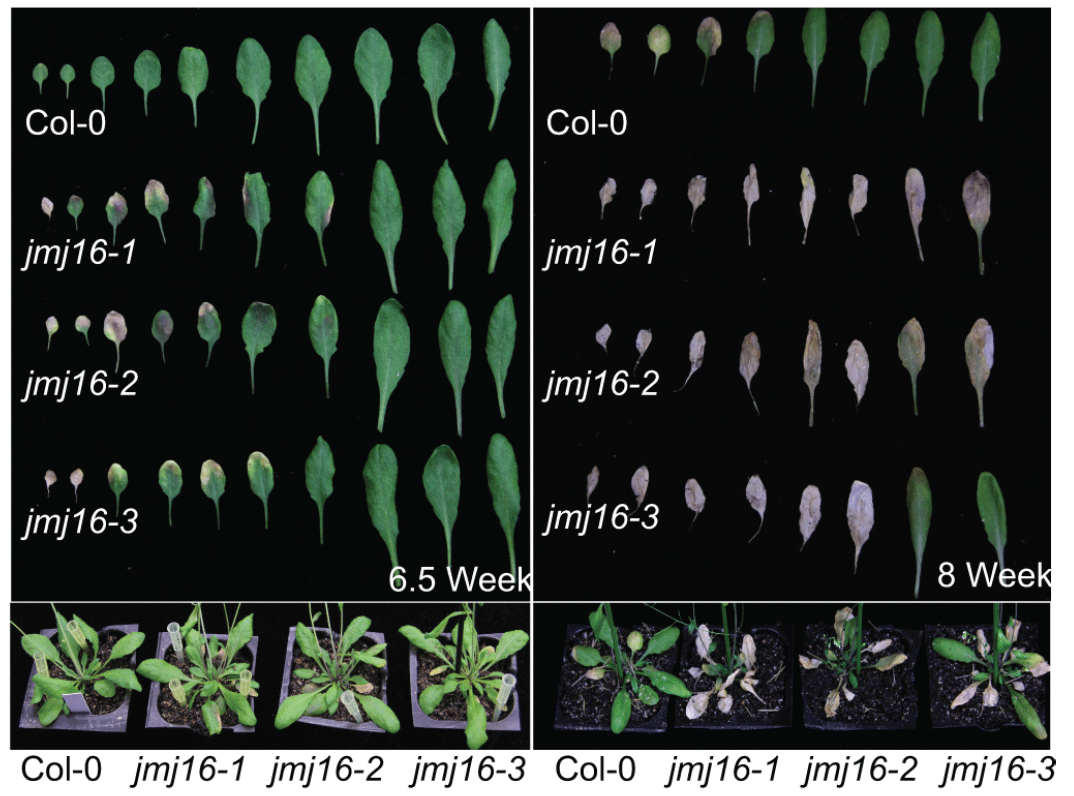博文
Plant Cell:拟南芥去甲基化酶JMJ16调控叶片衰老
||
The Histone H3K4 Demethylase JMJ16 Represses Leaf Senescence in Arabidopsis
First author: Peng Liu; Affiliations: Institute of Botany, Chinese Academy of Sciences (中科院植物所): Beijing, China
Corresponding author: Jing Bo Jin
Leaf senescence is governed by a complex regulatory network involving dynamic reprogramming of gene expression. Age-dependent induction of senescence-associated genes (SAGs) is associated with increased level of trimethylation of histone H3 at lysine 4 (H3K4me3), but the regulatory mechanism remains elusive. We found that JMJ16, an Arabidopsis JmjC-domain containing protein, is a specific H3K4 demethylase that negatively regulates leaf senescence through its activity. Genome-wide analysis revealed a widespread coordinated up-regulation of gene expression and hyper-methylation of H3K4me3 at JMJ16 binding genes associated with leaf senescence in the loss-of-function jmj16 mutant compared with the wild type. Genetic analysis indicated that JMJ16 negatively regulates leaf senescence at least partly through repressing the expression of positive regulators of leaf senescence, WRKY53 and SAG201. JMJ16 associates with WRKY53 and SAG201, and represses precocious expression of WRKY53 and SAG201 in mature leaves by reducing H3K4me3 levels at these loci. Interestingly, association of JMJ16 on WRKY53 and SAG201 loci increased at mature stage but decreased at later stage, suggesting that the age-dependent dynamic chromatin association of JMJ16 is required for precise transcriptional activation of SAGs during leaf senescence. Thus, JMJ16 is an important regulator of leaf senescence that demethylates H3K4 at SAGs in an age-dependent manner.
叶片衰老由一个复杂的网络所调控,涉及到基因表达的重编程。年龄依赖性诱导的衰老相关基因SAG与组蛋白h3赖氨酸4三甲基化H3K4me3水平的增加相关,但具体的分子调控机制还不清楚。作者发现拟南芥一个含有JmjC结构域的蛋白JMJ16是特异的H3K4去甲基化酶,其能够负调控叶片衰老。全基因组范围的分析显示相比于野生型,jmj16突变体中叶片衰老相关基因JMJ16结合位点上的H3K4me3超甲基化,基因表达量也有所上调。遗传学试验显示JMJ16负调控叶片衰老至少部分是通过抑制WRKY53和SAG201等叶片衰老正调控子来实现的。JMJ16结合WRKY53和SAG201,通过降低这些位点上的H3K4me3水平抑制WRKY53和SAG201在成熟叶片中的过早表达。有趣的是,JMJ16与WRKY53和SAG201位点的结合在成熟叶片中有所增加,而在后期则降低,说明JMJ16介导的年龄相关染色质动态变化对于叶片衰老过程中SAG的精确转录激活至关重要。因此,JMJ16是调控叶片衰老的重要蛋白,通过年龄相关模式去甲基化SAG上的H3K4而发挥作用。
通讯:金京波 (http://sourcedb.ib.cas.cn/cn/expert/201110/t20111006_3358936.html)
个人简介:1996年,中国农业大学,学士;1999年,韩国庆尚国立大学,硕士;2002年,韩国庆尚国立大学,博士;2002-2008年,韩国浦项工业大、美国普渡大学,博士后。
研究方向:以拟南芥和大豆为研究体系,鉴定SUMO化及组蛋白去甲基化调控植物发育、激素及环境胁迫的表观遗传学分子调控机制。
doi: https://doi.org/10.1105/tpc.18.00693
Journal: Plant Cell
First Published: February 01, 2019
https://blog.sciencenet.cn/blog-3158122-1160666.html
上一篇:Plant Biotechnol J:梨树SNP芯片开发利用
下一篇:Developmental Cell:拟南芥响应钙离子信号促进铁吸收的分子机制
全部作者的其他最新博文
- • Plant Physiology:CsMADS3促进柑果中的叶绿素降解和类胡萝卜素合成(华中农业大学)
- • Molecular Plant:LBD11-ROS反馈调节作用于拟南芥的维管形成层增殖和次生生长(浦项科技大学)
- • Science Advances:根结线虫通过调控植物的CLE3-CLV1模块,促进侵染进程(日本熊本大学)
- • Nature Communications:油菜素内酯参与植物营养生长期转变的分子机制解析(浙江农林大学)
- • Current Biology:光合作用产生的蔗糖驱动侧根“生物钟”(德国弗莱堡大学)
- • PNAS:花同源异型基因在叶中被抑制、花中被激活的分子机制(南卡罗来纳大学)

